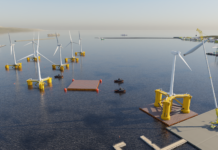A Cornish business is supporting a pioneering scheme in Wales to help prepare for floating offshore wind construction.
Falmouth-based Tugdock Limited is working with the Port of Milford Haven to help steer the development of floating offshore wind turbine assembly at its Pembroke Port facility.
The project will simulate the processes of manoeuvring large floating wind turbines into, and out from, Pembroke Port. These simulations will give a detailed understanding of the sequence of events that need to take place to successfully complete these phases of turbine recovery and deployment and help steer future planning for the port.
The project is a three-way collaboration between the Port of Milford Haven (which owns and operates Pembroke Port), Offshore Renewable Energy (ORE) Catapult, and Tugdock Limited.
Work is already well underway at Pembroke Port to establish a world class base for marine energy and engineering – a £60 million project part-funded by the Swansea Bay City Deal. The infrastructure at Pembroke Port is being adapted to accommodate the growing number of renewables developers who are seeking to base themselves there due to its proximity to the Celtic Sea.
Simon Cheeseman of ORE Catapult said: “This pioneering project is breaking new ground and will yield vital information that can help guide the investment and development strategy for Pembroke Port. This is the kind of innovative thinking that is needed in this fast-growing industry.”
Lucas Lowe-Houghton, director of business development for Tugdock, added: “Tugdock’s technology has been designed to help ports play a bigger role in floating offshore wind turbine assembly. It allows floating dry docks to be delivered by road in modular form and assembled at the port to dimensions far wider than most of the world’s existing dry docks.
“This technology can greatly increase the capacity of docks such as Pembroke Port. The floating platform is then towed to deeper water for launching of the turbines.”








